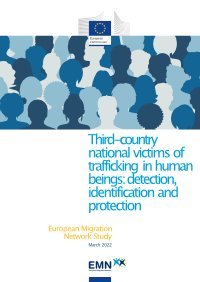Third-country national victims of trafficking in human beings: detection, identification and protection
By European Migration Network
Background and rationale for the study. Trafficking in human beings is a crime against people that can take various forms, such as sexual exploitation, forced labour or services, slavery and servitude-related practices, as well as the removal of organs, all of which constitute a grave violation of the victim’s fundamental rights. Trafficking in human beings is addressed under various EU and international instruments. One of the key priorities of the new EU Strategy on Combating Trafficking in Human Beings 2021-2025 is protecting, supporting and empowering victims, including their early identification. Working with relevant EU agencies is fundamental, as is engaging in cooperation and partnerships against trafficking with non-EU countries of origin and transit, and with organisations at regional and international level regarding the EU’s external relations policy.11 Between 2015 and 2020, more than 10 500 third-country national victims of trafficking in human beings were registered, with minors accounting for 8.5%, and sexual and labour exploitation representing approximately 75% of the cases. Trafficking in human beings is not only recognised as a highly profitable crime,12 but one with links to social development and security, migration, conflict and climate-induced displacement. The impact and cost of human trafficking on individuals and on political, economic and social systems is enormous. Given its clandestine nature and the myriad factors that may deter a victim 11 Renewed EU action plan against migrant smuggling (2021-2025),
Brussels, Belgium: Directorate General for Migration and Home Affairs, European Commission, 2022. 60p.


